
The canton of Bern or Berne is one of the 26 cantons forming the Swiss Confederation. Its capital city, Bern, is also the de facto capital of Switzerland. The bear is the heraldic symbol of the canton, displayed on a red-yellow background.

Unspunnenfest is a festival held in the town of Interlaken, Switzerland, near the old ruin of Unspunnen Castle, in the Bernese Alps, approximately once every twelve years, most recently in 2017. The festival highlights traditional Swiss culture and features competitions of Steinstossen, Schwingen (wrestling) and yodeling. The stone-throwing competition uses an 83.5 kg (184.1 lb) stone known as the Unspunnenstein, made of Aare granite from the Hasli valley.

Wilderswil is a village and a municipality in the Interlaken-Oberhasli administrative district in the canton of Bern in Switzerland.

The Burgdorferkrieg or Kyburgerkrieg was a war in 1383-84 between the counts of Neu-Kyburg and the city of Bern for supremacy in the County of Burgundy in what is now Switzerland.

Oberhofen Castle is a castle in the municipality of Oberhofen of the Canton of Bern in Switzerland. It is a Swiss heritage site of national significance.
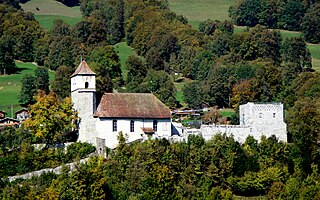
Ringgenberg Castle is a castle in the municipality of Ringgenberg of the Canton of Bern in Switzerland. It is a Swiss heritage site of national significance.

Rümligen Castle is a castle in the municipality of Rümligen of the Canton of Bern in Switzerland. It is a Swiss heritage site of national significance.
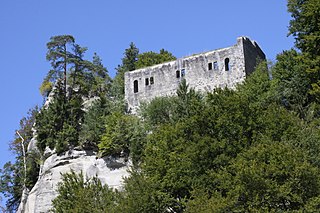
Grasburg Castle is a ruined castle in the municipality of Schwarzenburg of the Canton of Bern in Switzerland. It is the largest castle ruin in the Canton of Bern. It is a Swiss heritage site of national significance.

Wimmis Castle is a castle in the municipality of Wimmis of the Canton of Bern in Switzerland. It is a Swiss heritage site of national significance.
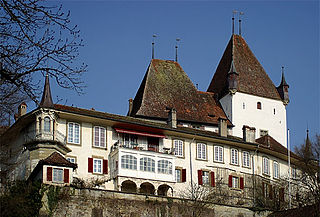
Worb Castle is a castle in the municipality of Worb of the Canton of Bern in Switzerland. It is a Swiss heritage site of national significance.
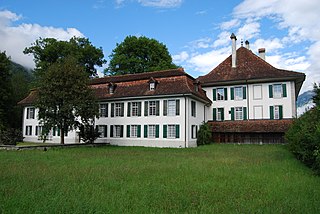
Interlaken Monastery was a convent of the Augustinian Canons Regular from about 1133 until 1528 at Interlaken in the canton of Bern in Switzerland. It is a Swiss heritage site of national significance.

The Gümmenenkrieg was a war between the emergent city-states of Bern and Fribourg in 1331-33 in what is now Switzerland. The war pitted Bern and the new Swiss Confederation against the Habsburg-supported city of Fribourg and local nobles. It was also the first in a series of battles that brought the Habsburgs and Fribourg into prominence in the County of Burgundy. The war ended without resolving anything and led to other wars between Bern and Fribourg.

The ruins of Grünenberg Castle, Schnabelburg Castle and Langenstein Castle are a complex of three interconnected castles on a hill above the municipality of Melchnau in the canton of Bern in Switzerland. The three castles formed the center of power of the Barons of Grünenberg in the Oberaargau region during the High Middle Ages.
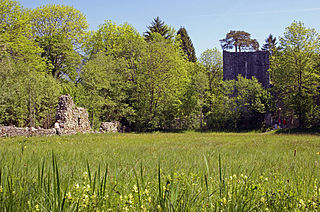
Weissenau Castle is a ruined castle in the municipality of Unterseen of the Canton of Bern in Switzerland. It is a Swiss heritage site of national significance.

Oberer Mannenberg Castle is a ruined castle in the municipality of Zweisimmen of the canton of Bern in Switzerland. It is a Swiss heritage site of national significance.

Brandis Castle is the ruin of a hill fort from the 13th century. It stands in the Swiss municipality of Lützelflüh in the Canton of Bern above the village Lützelflüh on a rocky outcrop. Today, only the ruins and the moat are still visible.
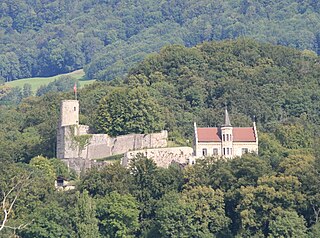
Bipp Castle is a partially ruined castle in the municipality of Oberbipp of the Canton of Bern in Switzerland.
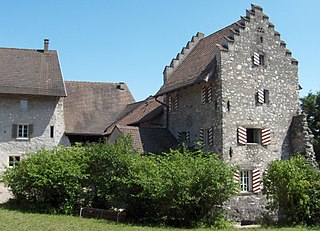
Altenburg Castle is a castle in the village of Altenburg bei Brugg in the municipality of Brugg in the canton of Aargau in Switzerland. The castle and the Altenburg Roman ruins, which are integrated into it, are classified as Swiss heritage site of national significance.

Weissenburg Castle is a ruined castle in the municipality of Därstetten of the Canton of Bern in Switzerland.

Thurnen is a municipality in the Bern-Mittelland administrative district in the canton of Bern in Switzerland. On 1 January 2020 the former municipalities of Kirchenthurnen, Lohnstorf and Mühlethurnen merged to form the new municipality of Thurnen.






















